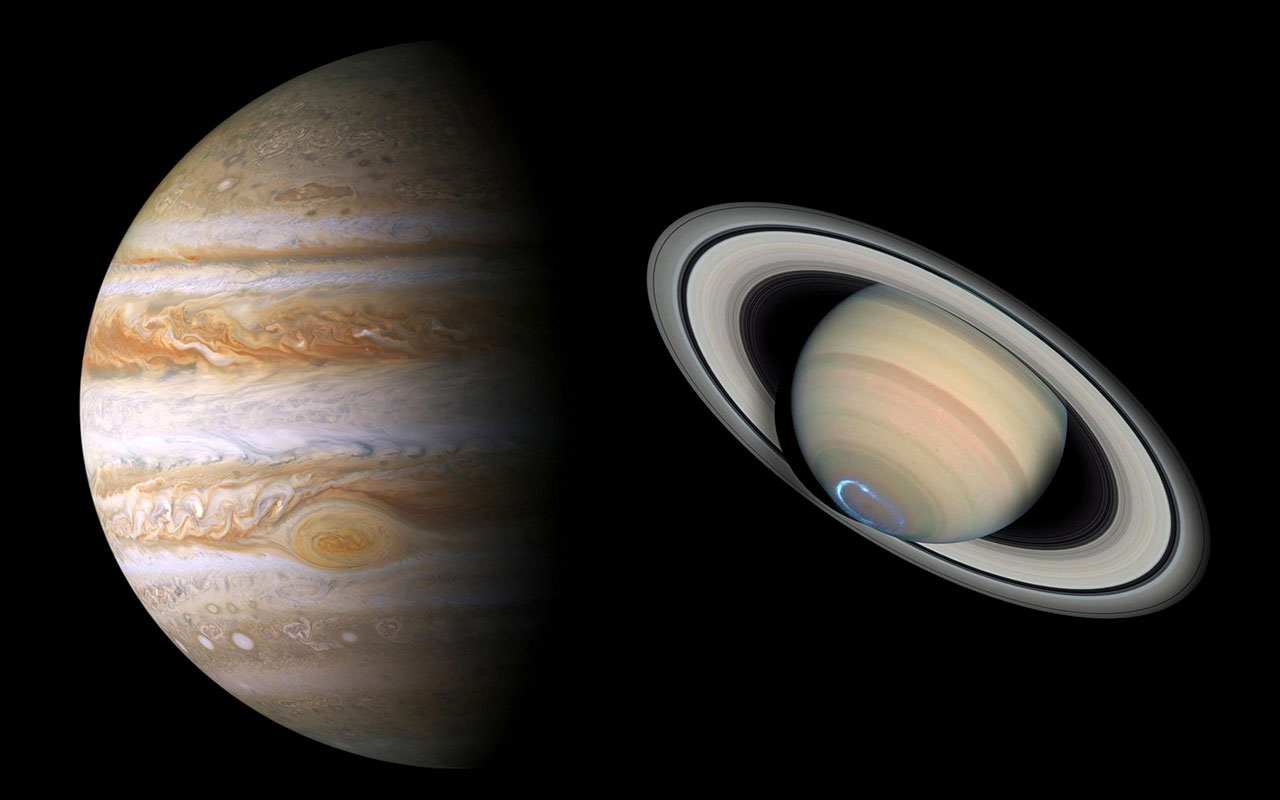
Supercomputers Boost Understanding of Distance between Jupiter and Saturn
‘Comet’ and ‘Bridges’ run thousands of simulations for orbit study
Published Date
By:
- Kimberly Mann Bruch
Share This:
Article Content
The solar system’s two largest planets, Jupiter and Saturn, received worldwide publicity on December 21, 2020, as they glided closer than they’ve been since 1623. Visible around the globe, “The Great Conjunction” placed the two planets only 0.1 degree apart from one another.
Typically, Jupiter and Saturn have been known to “keep their distance” from one another. Understanding why these two planets have so much space between them was the focus of a recent Icarus journal article. Born Eccentric: Constraints on Jupiter and Saturn’s Pre-Instability Orbits encompassed the analysis of supercomputer simulations by an international team of researchers—thanks to allocations on supercomputers by the National Science Foundation’s (NSF) Extreme Science and Engineering Discovery Environment (XSEDE).
Comet, a supercomputer at the San Diego Supercomputer Center at UC San Diego, and Bridges at the Pittsburgh Supercomputing Center were used to run more than 6,000 simulations to better understand the space between the two planets. The simulations’ development and analyses was led by Carnegie Institution of Washington Postdoctoral Fellow Matthew Clement, who teamed with astronomer Sean Raymond of the Laboratoire d’ Astrophysique de Bordeaux in Pessac, France, and several researchers from the University of Oklahoma, Rice University, and the Southwest Research Institute.
“We are fairly certain that the giant planets, including Jupiter and Saturn, were born closer together than they are today and one challenge to determine how and why they are now so far apart is to better understand how Jupiter’s orbit became so eccentric and elliptical,” said Clement. “Historically, simulations that reproduce Jupiter’s orbital shape tend to push Saturn too far out in to the outer solar system, beyond where Uranus is today, so with our study, we used initial conditions consistent with hydrodynamical models of the giant planets forming in gaseous proto-planetary disks to more consistently generate Jupiter- and Saturn-like orbits.”
According to scientists, the interplay of these two gas giants’ orbits drives a good amount of the solar system’s evolution as a whole. Jupiter itself makes up about two-thirds of all the total mass in planets, asteroids, and comets in the solar system. Meanwhile, Saturn comprises the majority of the rest of the material.
“The orbital dance that Jupiter and Saturn perform today drive a myriad of dynamical effects in the solar system, and likely affected the Earth’s growth in the past,” explained Clement. “This helps us understand why Earth is a nice temperate and water-rich place where we can live, while Mars and Venus are quite inhospitable to life as we know it.”
While previous studies have assumed that Jupiter and Saturn were born in what is known as a 3:2 mean motion resonance (Jupiter went around the Sun three times for every two Saturn cycles), Clement’s research considered an initial 2:1 resonance (two Jupiter orbits for every one of Saturn’s). Thus, the planets formed farther apart.
“This is the best way to explain the planets’ modern orbital dance,” he said. “Interestingly, perhaps the best observed photo-planetary disk, known as PDS-70, a system of planets in the process of growing, seems to be dominated by two giant planets similar to Jupiter and Saturn in our own solar system also in a 2:1 resonance.”
Understanding Jupiter and Saturn in this manner also helps planetary scientists compare our own system of planets to the large contingent of discovered exoplanets. Clement said that if we were observing our own solar system from afar with current techniques, we would only be able to detect Jupiter and Saturn – not any of the other planets. However, when we look at the population of planets detected so far with masses similar to that of Jupiter and Saturn, their orbits look nothing like those in the solar system.
Some systems host Jupiter-like planets on very short orbits, closer to the sun than Mercury (the so-called hot Jupiters). Others host Jupiter- and Saturn-like planets on more distant orbits like those of the actual Jupiter and Saturn). However their orbital eccentricities are extremely high, like comets have in our solar system. There are also a few systems with four or more giant planets on wide orbits with low eccentricities such as our giant planets have, but they are in a chain of resonances. So, the solar system exists in the curious “middle ground” between those last two types of systems, according to the researchers.
“Our work essentially tries to understand why we appear to be the ‘missing link’ between these two types of systems, and our results indicate that this is because of Jupiter and Saturn formed in the 2:1 resonance rather than a more compact chain like the 3:2,” said Clement. “Because this is such a highly chaotic process, we would not have been able to take our project to this scale of thousands of simulations without Comet and Bridges.”
Key funding for this research was provided by the National Science Foundation (AST-1615975), an NSF CAREER award (1846388), the NASA Astrobiology Institute (NNH12ZDA002C and NNA13AA93A), and NASA (80NSSC18K0828). Computing time on Comet and Bridges was awarded via XSEDE (TG-AST200004).
Share This:
You May Also Like
Stay in the Know
Keep up with all the latest from UC San Diego. Subscribe to the newsletter today.



